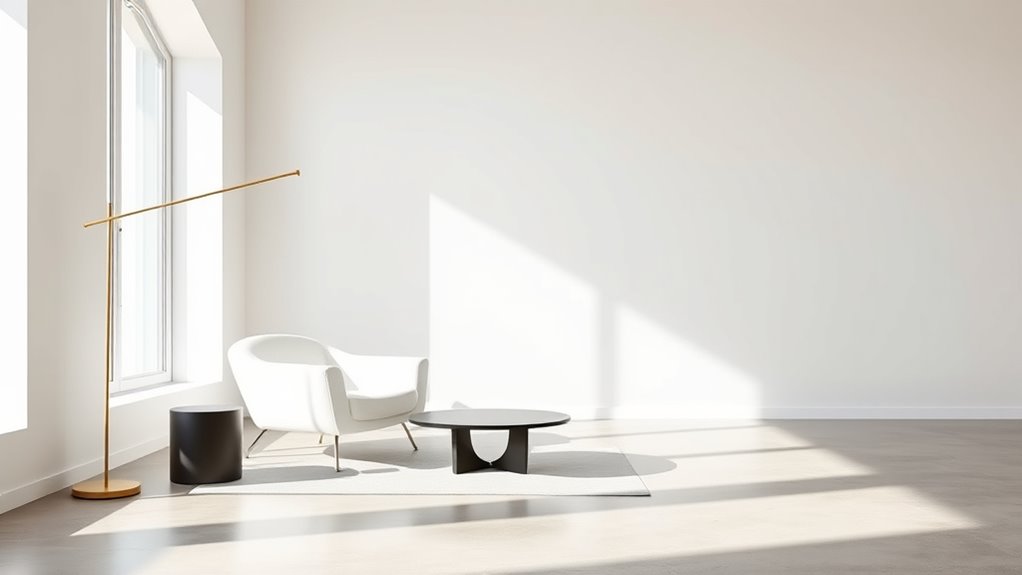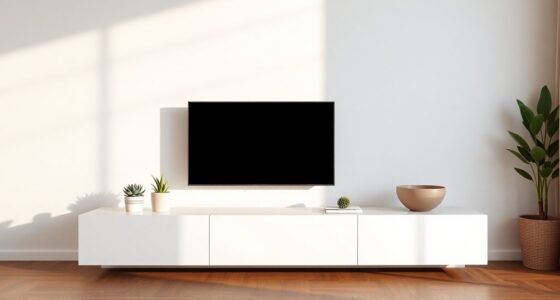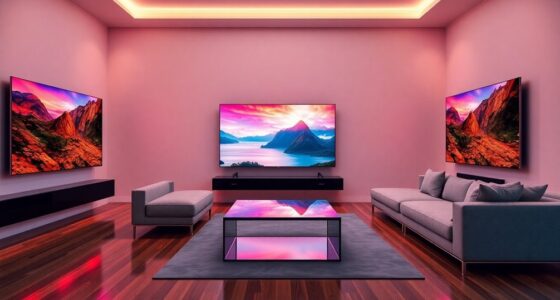In 2026, minimalist design will focus on smart, adaptable spaces with hidden storage, modular furniture, and eco-friendly materials. You’ll notice personalized elements, natural textures, and bold accents that create warmth within simplicity. Technology like AR and VR will enhance your experience of clean, functional environments. Lighting techniques will add depth through shadows, and cultural influences will blend tradition with modernity. Keep exploring to discover how these trends will shape your future spaces.
Key Takeaways
- Storage solutions will be highly discreet, with hidden compartments and modular furniture optimizing space and reducing visual clutter.
- Biophilic and adaptive designs will blend natural elements with tech-integrated, reconfigurable spaces for personalized, tranquil environments.
- Neutral color palettes with textured accents and cultural fusion will create warm, layered minimalist aesthetics.
- Virtual and augmented reality will enhance immersive, clutter-free digital experiences aligned with minimalism.
- Innovative use of light and shadow will add depth and visual interest, emphasizing clean lines and negative space.
The Rise of Adaptive Minimalism in Tech-Integrated Spaces
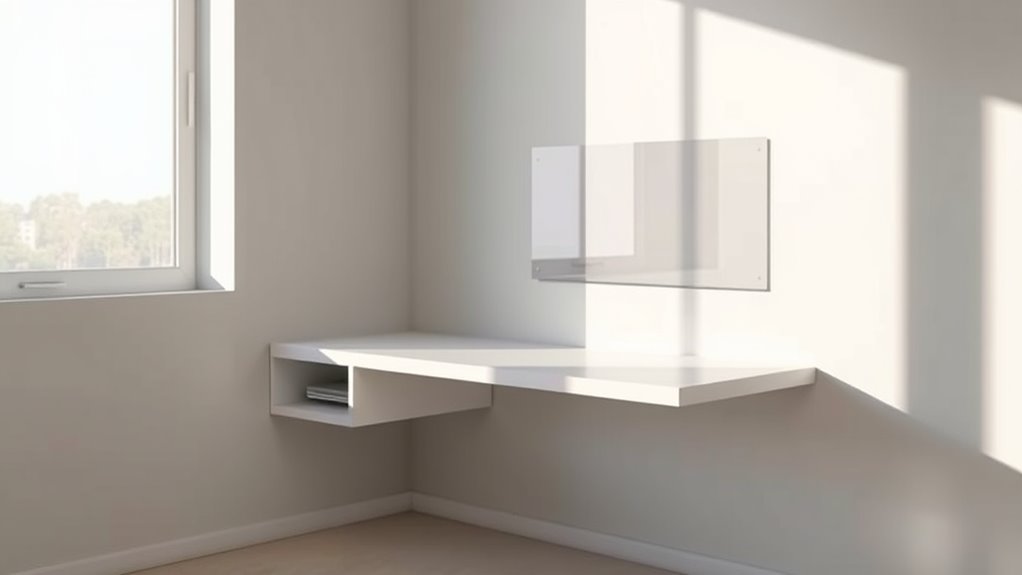
As technology becomes more integrated into our daily lives, adaptive minimalism is gaining momentum in design. You’ll notice spaces that seamlessly adjust to your needs through adaptive interfaces, offering a personalized experience. In dynamic environments, furniture and features respond to your presence, transforming to optimize comfort and functionality. This approach reduces clutter by hiding or reconfiguring elements based on context, creating clean, uncluttered spaces that still serve multiple purposes. Additionally, smart home automation enhances simplicity rather than complicates it, making your environment feel intuitive and effortless. As designers embrace adaptive minimalism, your space will become more flexible, responding intelligently to your habits and routines. Incorporating space optimization techniques further supports the goal of a clutter-free, adaptable living area, ensuring that every inch of your space is used effectively. Moreover, integrating health benefits of minimalism, such as reducing stress and promoting well-being, can make these environments even more beneficial for occupants.
Eco-Conscious Materials and Sustainable Design Practices

With increasing awareness of environmental impact, designers are turning to eco-conscious materials and sustainable practices to shape the future of minimalism. You’ll see a rise in biodegradable textiles that reduce waste and lessen environmental harm, making your spaces both stylish and eco-friendly. Additionally, the integration of electric bike conversion kits demonstrates a shift towards sustainable transportation solutions that complement minimalist urban lifestyles. Recycled metal accents will become more common, adding subtle industrial touches while conserving resources. These materials help create clean, simple lines without sacrificing sustainability. Minimalist designs will emphasize transparency about material sources, encouraging conscious consumption. You’ll find furniture and decor that prioritize longevity and recyclability, aligning aesthetic appeal with environmental responsibility. Recognizing signs of spoilage in materials and products can also promote a mindful approach to sustainable living, ensuring longevity and reducing waste. Furthermore, awareness of material durability can guide consumers in selecting long-lasting items that minimize the need for frequent replacement. Implementing fraud prevention tools in supply chains can also help verify the authenticity of eco-friendly materials, supporting ethical sourcing.
Personalization Through Modular and Transformable Elements
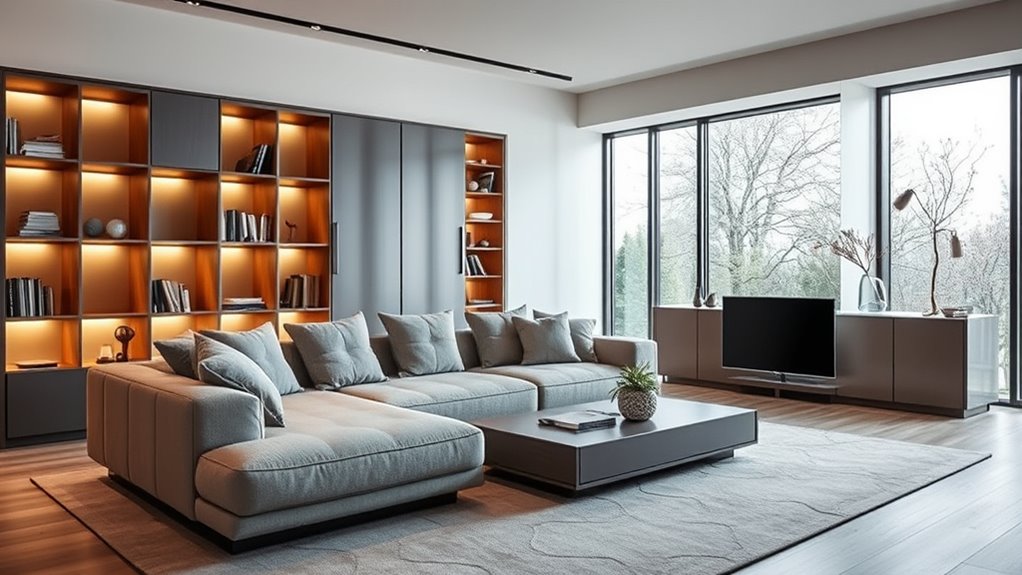
Modular and transformable elements are redefining personalization in minimalist design, allowing you to adapt your space effortlessly to different needs and moods. With custom modularity, you can create furniture and setups that fit your lifestyle perfectly, switching functions or styles as desired. Additionally, the integration of family influences can inspire unique design choices that reflect personal heritage and cultural background. Flexible configurations enable you to optimize your space for versatile usage, making it suitable for various activities and occasions. This flexibility ensures your space remains sleek yet functional, reflecting your evolving tastes and requirements. Incorporating water-resistant materials can further enhance the practicality and longevity of your adaptable designs, especially in environments prone to moisture or spills. Considering local investment options can also provide additional funding avenues for your design projects, ensuring your space stays innovative and adaptable. Exploring renewable energy solutions like solar-powered systems can contribute to making your home more sustainable and energy-efficient, aligning with minimalist principles. Personalized transformations enable you to tailor your environment without clutter, swapping out components or reconfiguring pieces for new aesthetics or purposes. This flexibility ensures your space remains sleek yet functional, reflecting your evolving tastes and requirements.
Neutral Palettes With Unexpected Accents and Textures
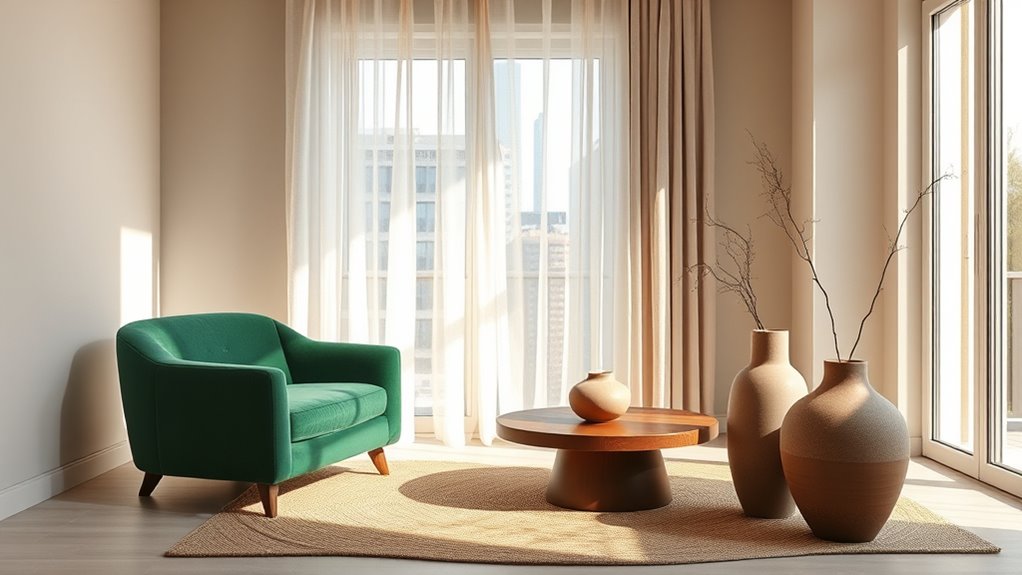
Neutral palettes continue to dominate minimalist design, providing a calm and versatile backdrop for your space. To elevate this simplicity, incorporate unexpected accents and textures that surprise and engage.
Monochrome palettes create a seamless, soothing environment, while textured fabrics add depth and tactile interest. You can introduce subtle variations with layered materials or contrasting finishes. Think about adding a plush velvet cushion or a woven throw in your neutral tones.
Incorporate matte and gloss surfaces to create visual intrigue without disrupting the minimalist aesthetic. These small touches keep your space feeling fresh and dynamic while maintaining the overall calm. Understanding material finishes can help you achieve this balance effectively. Additionally, exploring lighting techniques can further enhance the textural contrasts and overall ambiance.
Embracing unexpected accents within a neutral palette allows you to express personality effortlessly, keeping your environment both functional and beautifully understated. Textured fabrics and layered materials can enhance the tactile experience and add visual interest, making your space feel more inviting and personalized.
Smart Storage Solutions for Clutter-Free Environments
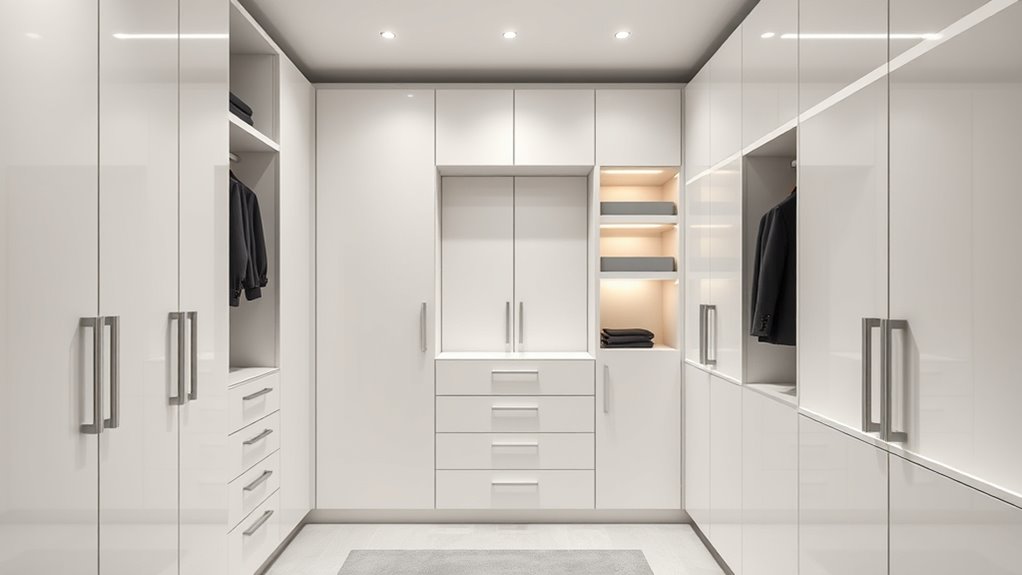
Smart storage solutions will help you maintain a clutter-free space effortlessly. Hidden innovations like built-in compartments and concealed drawers maximize every inch of your home. Incorporating versatile dishes can also reduce the need for multiple containers and storage items. Modular designs also give you the flexibility to customize and adapt your storage as your needs change. Additionally, integrating self-watering planters into your storage options can promote healthier plant growth while saving space and reducing maintenance efforts. Modern materials and space-saving furniture further enhance storage efficiency in compact environments. As cybersecurity threats evolve, designing your home with security-focused features can further protect your belongings and personal information.
Hidden Storage Innovations
Have you ever wished your storage solutions could disappear into the background? Hidden storage innovations make that possible. Advances in concealed storage and hidden compartments are transforming minimalist spaces, allowing you to keep clutter out of sight effortlessly. Incorporating emotional support principles can also help you feel more at ease with decluttering and organizing your environment. Think furniture with built-in secret drawers, beds with under-mattress storage, and walls that conceal entire cabinets. These innovations maximize space without sacrificing style. You can now hide everyday essentials or valuables seamlessly, maintaining a clean, streamlined look. With smart design, hidden compartments blend into your environment, making clutter invisible. The focus shifts from visible storage to discreet, integrated solutions that elevate your minimalist aesthetic. Embrace these innovations to create a clutter-free environment that feels open, calm, and effortlessly organized.
Modular Design Flexibility
As living spaces become more versatile, modular design offers unmatched flexibility for creating clutter-free environments. You can customize storage to suit your needs, blending sustainable materials with cultural influences for a unique aesthetic. Modular systems adapt easily, allowing you to reconfigure spaces as your lifestyle evolves. Imagine furniture that transforms from a bookshelf to a workspace, seamlessly integrated into your environment. Here’s a glimpse of how flexible modules can enhance your space:
| Module Type | Function | Cultural Influence |
|---|---|---|
| Fold-away beds | Maximize small spaces | Japanese minimalism |
| Sliding panels | Conceal storage or divide | Scandinavian simplicity |
| Convertible desks | Multi-use workstations | Modern industrial |
| Hidden compartments | Keep clutter out of sight | Traditional craftsmanship |
Biophilic Minimalism: Integrating Nature Seamlessly
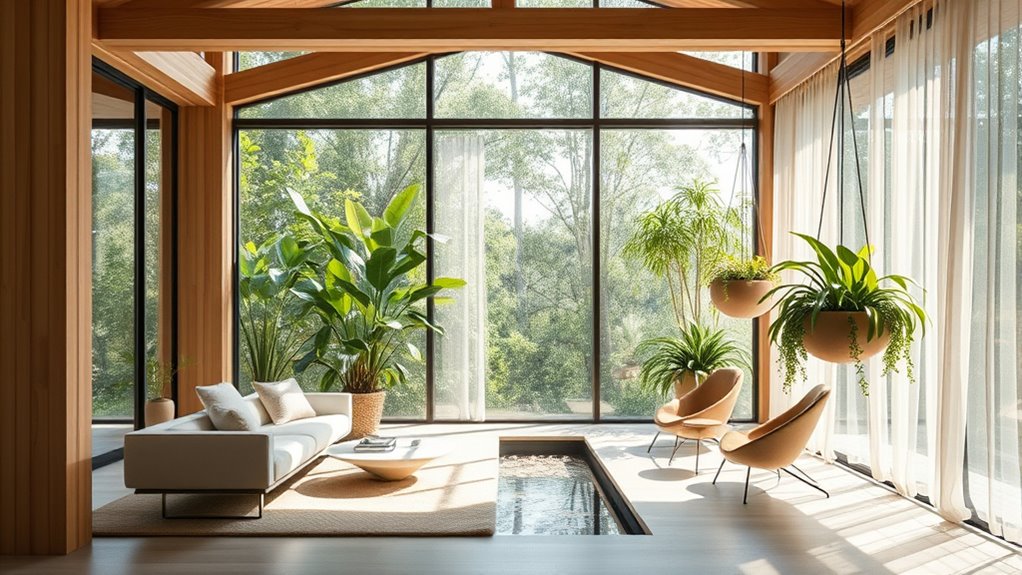
While minimalist design emphasizes simplicity and clean lines, biophilic minimalism elevates this approach by seamlessly integrating natural elements into everyday spaces. You’ll notice a shift toward incorporating nature-inspired textures and organic material palettes, creating environments that feel both calming and authentic.
This style emphasizes harmony with nature, promoting well-being and tranquility. To achieve this, you might include features like living walls, large windows for natural light, or furniture made from sustainable materials.
The goal is to blur the line between indoors and outdoors, making nature a core design element. As a result, your space becomes a sanctuary that nurtures your mental health and enhances aesthetic appeal.
This approach transforms minimalism from sterile to warmly inviting and inherently connected to the natural world.
Minimalist Workspaces Supporting Remote and Hybrid Models
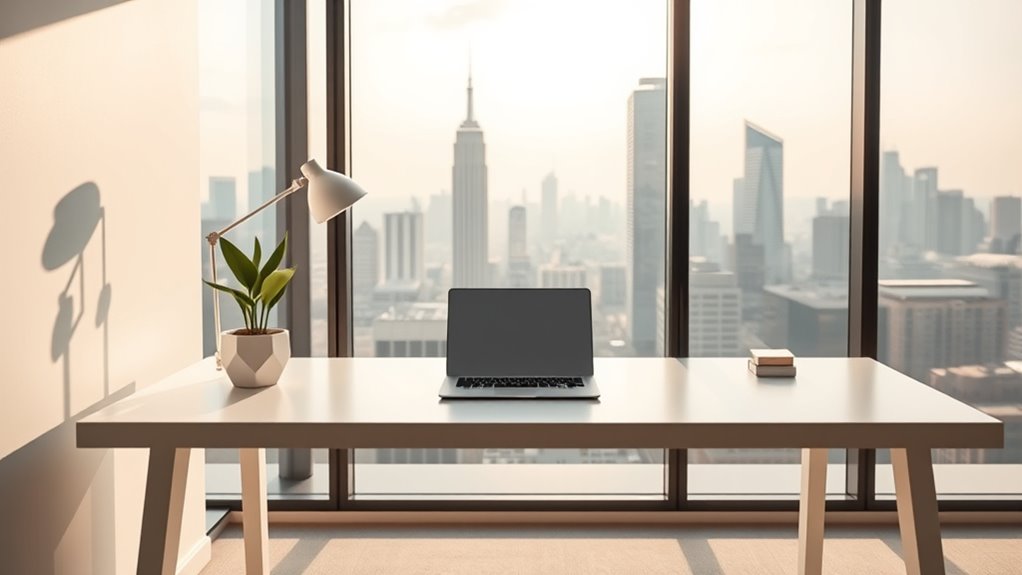
You’ll find that minimalist workspaces are designed for flexibility, allowing you to easily switch between different configurations as needed.
Tech-integrated environments keep your tools streamlined and clutter-free, supporting seamless remote and hybrid work.
These designs help you stay focused and productive in a space that adapts to your changing work routines.
Flexible Space Configurations
How can flexible space configurations enhance minimalist workspaces to better support remote and hybrid models? By integrating adaptive furniture and flexible layouts, you create environments that easily adjust to your changing needs.
This approach maximizes space efficiency while maintaining a clutter-free look. You can transform a single area into a collaborative zone or a quiet retreat with minimal effort. The key is using adaptable elements that support diverse activities without sacrificing simplicity.
- Incorporate modular furniture that can be rearranged quickly
- Design zones that serve multiple functions with movable partitions
- Choose storage solutions that blend seamlessly into the minimal aesthetic
Tech-Integrated Environments
Integrating smart technology into minimalist workspaces transforms how remote and hybrid teams collaborate and stay productive.
You’ll find privacy zones strategically designed with acoustic privacy features, enabling focused work and confidential conversations without disrupting the open layout.
Smart sound masking systems create a tranquil environment, blocking noise and maintaining privacy in shared spaces.
Automated lighting and climate controls enhance comfort while reducing clutter, supporting a clean, efficient aesthetic.
Digital dashboards and wireless charging stations keep essential tools accessible and organized.
These tech integrations ensure your workspace remains sleek, functional, and adaptable to your needs.
Innovative Use of Light and Shadow to Enhance Simplicity
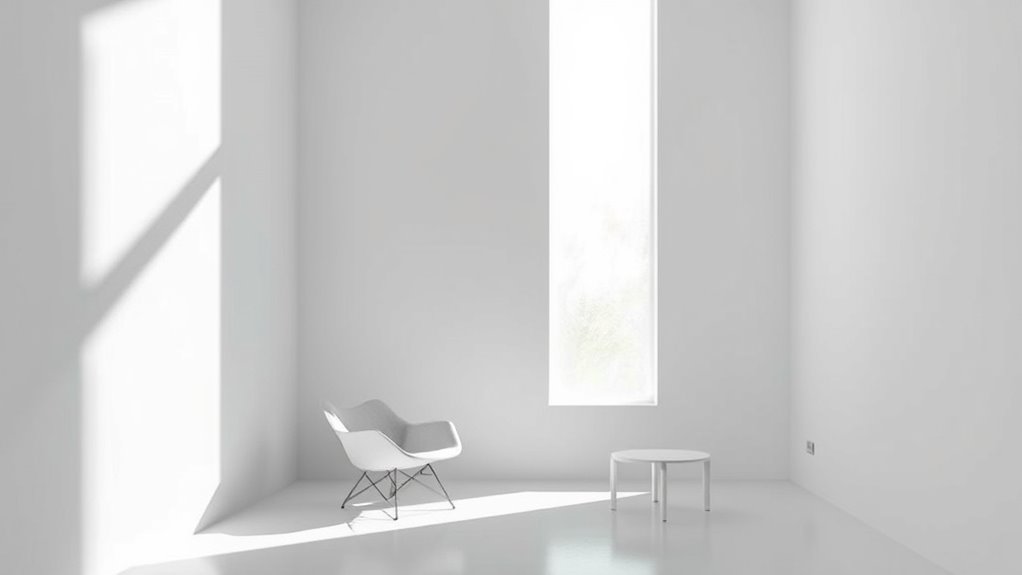
As minimalist design continues to evolve, the innovative use of light and shadow has become a key tool for creating striking yet simple visuals. By mastering light manipulation and shadow play, you can add depth and dimension without clutter.
Subtle shifts in lighting highlight essential features, guiding the viewer’s eye naturally. Shadow techniques create contrast, emphasizing clean lines and negative space. This approach fosters calmness and clarity while adding visual interest.
You might experiment with natural light to enhance texture or use focused artificial lighting for dramatic effects. The goal remains simplicity, but with a sophisticated edge. Incorporating these techniques allows your designs to communicate more with less, making light and shadow crucial tools for the minimalist aesthetic of 2026.
The Fusion of Minimalism With Cultural and Artistic Influences
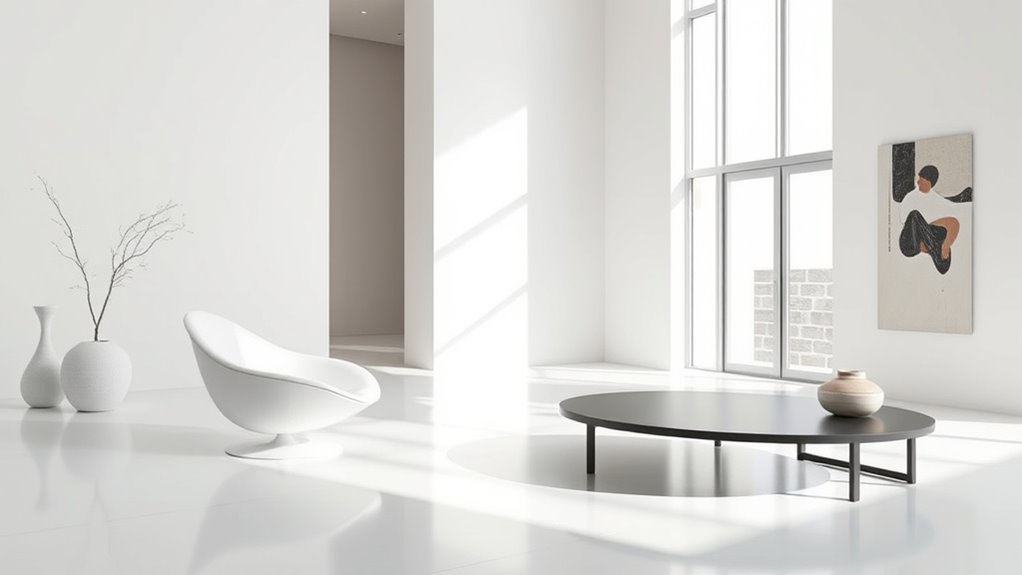
You’ll see cultural symbols and artistic expressions seamlessly integrated into minimalist designs, creating deeper meaning.
This fusion reflects global aesthetic trends that celebrate diversity while maintaining simplicity.
As a result, your environment becomes a canvas of shared stories and artistic innovation.
Cultural Symbols in Design
Cultural symbols are increasingly shaping minimalist design by infusing it with deeper meaning and identity. You’ll notice how designers incorporate cultural symbols to tell stories visually, adding layers of significance without clutter.
This approach enhances design storytelling, creating a connection between the viewer and the culture behind the symbols. By doing so, minimalism becomes more than simple aesthetics; it becomes a vessel for cultural expression.
- Using traditional motifs subtly integrated into modern forms
- Incorporating symbols that evoke shared heritage or values
- Merging cultural artifacts with sleek, minimal lines for a balanced contrast
This fusion allows you to communicate complex narratives through clean, thoughtful design, making cultural symbols a powerful tool in shaping minimalist aesthetics in 2026.
Artistic Expression Integration
Integrating artistic expression into minimalist design allows for a richer dialogue between tradition and innovation. You’ll see designers using digital brushstrokes that mimic traditional art, adding texture and emotional depth without clutter.
Conceptual collages also become prominent, combining unexpected visual elements to evoke cultural narratives subtly woven into the simplicity. This fusion lets you experience a layered storytelling, where minimalism isn’t about stripping away meaning but highlighting it through artistic techniques.
By blending digital artistry with minimal forms, designers create spaces and objects that feel both contemporary and rooted in cultural expression. This approach encourages you to engage more deeply, appreciating the nuanced fusion of artistic influences within a minimalist framework.
The result is a dynamic harmony that elevates both tradition and innovation in design.
Global Aesthetic Trends
As minimalist design continues to evolve, it increasingly incorporates diverse cultural and artistic influences, creating a global aesthetic that’s both simple and richly layered.
You’ll notice a rise in cultural reinterpretations in minimalist spaces, blending traditional motifs with sleek forms. This fusion reflects global design influences, where diverse styles converge to inspire fresh perspectives.
These trends encourage you to embrace authenticity while maintaining clarity and simplicity. Expect designs to feature subtle nods to different cultures, such as intricate patterns or color palettes inspired by distant regions, all balanced with minimalist restraint.
This approach fosters a deeper connection to global heritage without sacrificing the clean, uncluttered look that defines minimalism. The result is a harmonious blend of tradition and modernity that appeals worldwide.
Virtual and Augmented Reality Enhancing Minimalist Experiences
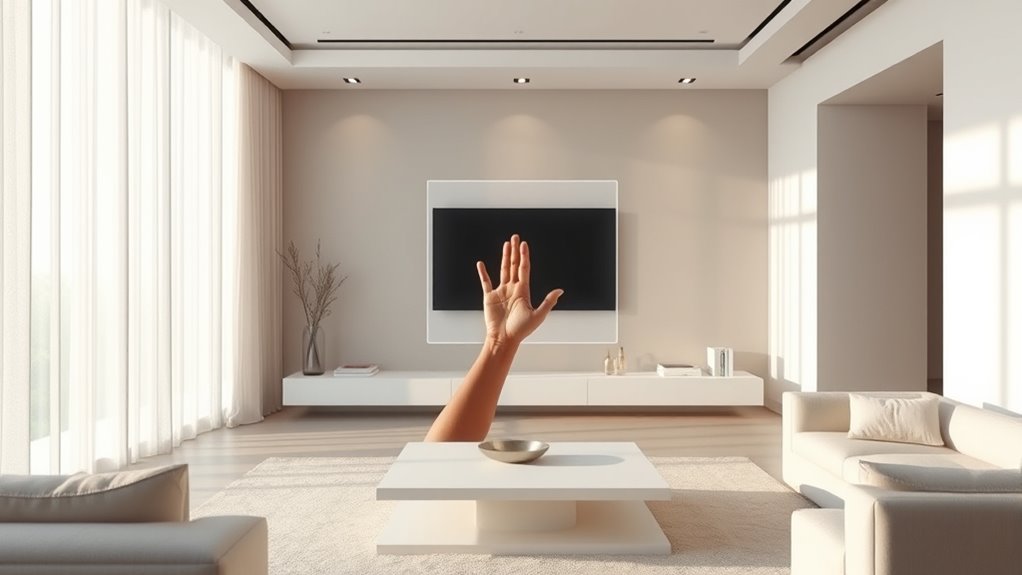
Virtual and augmented reality are transforming minimalist design by creating immersive experiences that emphasize simplicity and functionality. With holographic overlays, you can project clear, streamlined visuals that blend seamlessly into your environment, reducing clutter and distraction.
Virtual object interaction allows you to manipulate digital elements intuitively, making interfaces more engaging without adding complexity. These technologies help you focus on essential features, removing unnecessary layers and enhancing user experience.
As you explore virtual and augmented environments, you’ll notice how minimalist principles guide the design—prioritizing clean lines, open space, and purpose-driven interfaces. This combination of immersive tech and minimalism invites you to interact naturally, making digital interactions more effortless and visually calming.
Ultimately, these innovations redefine how you experience simplicity in digital spaces.
Frequently Asked Questions
How Will Minimalist Design Adapt to Future Technological Innovations?
You’ll see minimalist design evolving with adaptive technology and smart home integration. As these innovations become more common, you’ll likely notice cleaner, more functional spaces that seamlessly incorporate smart devices.
Minimalism will adapt by blending form with technology, making your environment more intuitive and efficient. You’ll enjoy a sleek aesthetic that simplifies your life, with intelligent systems enhancing comfort without clutter.
This will create a future-proof, streamlined living space.
What Emerging Sustainable Materials Will Define Minimalist Interiors in 2026?
You’ll see sustainable innovation shaping minimalist interiors with eco-friendly materials like mycelium-based composites, which could make up 15% of interior surfaces by 2026. These materials offer durability and biodegradability, aligning with eco-conscious trends.
As minimalism evolves, you’ll notice designers prioritizing natural, renewable resources, reducing waste, and embracing innovative, sustainable options that enhance simplicity while supporting environmental responsibility.
How Will Personalization Evolve Within Minimalist Space Constraints?
You’ll see personalization trends focus on clever space optimization, making minimal spaces feel uniquely yours. Instead of clutter, you’ll use multifunctional furniture and customized accents that reflect your style without overcrowding.
Smart storage solutions, modular pieces, and subtle decorative elements will help you create a personalized environment within limited space. This approach balances individual expression with the minimalist ethos, ensuring your space feels tailored while remaining clean and functional.
Can Minimalist Aesthetics Incorporate Diverse Cultural Influences Seamlessly?
Did you know 65% of design enthusiasts value cultural fusion in minimalist spaces? You can seamlessly incorporate diverse cultural influences by blending traditional elements with sleek, modern aesthetics, creating aesthetic diversity.
Minimalist design isn’t about uniformity; it’s about harmony. By thoughtfully selecting culturally inspired accents, you achieve a balanced, compelling look that celebrates global influences without clutter, making your space uniquely vibrant and inclusive.
What Role Will Virtual Reality Play in Designing Minimalist Environments?
Virtual reality will revolutionize how you design minimalist environments by enabling virtual immersion and enhancing sensory engagement. You’ll effortlessly explore clean, uncluttered spaces in a fully immersive way, allowing you to refine layouts, colors, and lighting intuitively.
VR helps you experience minimalist designs firsthand before implementation, making adjustments seamlessly. This technology bridges the gap between concept and reality, empowering you to craft serene, balanced spaces that truly resonate with your vision.
Conclusion
By 2026, minimalist design will seamlessly blend technology, sustainability, and personalization, creating spaces that feel both calming and inspiring. You’ll find yourself surrounded by adaptable, eco-friendly elements that reflect your unique style while supporting a clutter-free life. As you embrace these evolving trends, ask yourself: isn’t it time to redefine simplicity in a way that truly enhances your everyday experience? Ultimately, minimalist design is about more than aesthetics—it’s about crafting meaningful, intentional environments.
